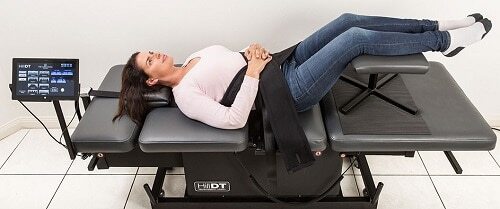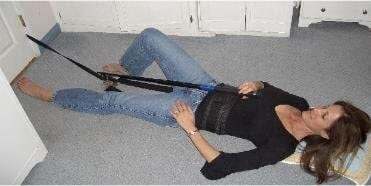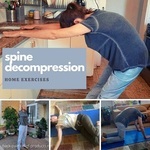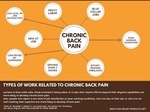According to the latest back pain statistics, spinal decompression devices are being used by 38% of chiropractic doctors and traction usage has risen from 73% in 1991 to 80.6% in 2003 and keeps rising to this day.
But, what is the success rate of spinal decompression? Does it actually work?
In this post, you’ll find all the important studies and spine decompression statistics available to help you understand why so many people are using this technology to relieve back pain and heal herniated, bulging discs, and degenerative discs.
Overview
- What is Non-Surgical Spinal Decompression?
- What is the Success Rate of Spinal Decompression?
- 1. Traction in the chiropractor’s office has risen from 73.2% in 1991 to 80.6% in 2003
- 2. 86% Reduction of Back Pain After Using a Lumbar Stretcher
- 3. 71% Success in Pain Reduction/Elimination Following 10 Spine Decompression Sessions
- 4. Spine Decompression Increases Disc Height by 15% (After Only 6 Sessions)
- 5. 30%-60% Body Weight Traction is More Effective
- How Long Does it Take to See Results from Spinal Decompression?
- How Much Does Spinal Decompression Cost?
- How to Do Spinal Decompression at Home
What is Non-Surgical Spinal Decompression?

Non-surgical spinal decompression devices gently stretch the spine, which changes its force and position and takes the pressure off the spinal discs by creating negative pressure in them.
The result?
Bulging or herniated discs can retract, taking the pressure off the surrounding nerves (this pressure causes Sciatica symptoms, for example) and other structures around the spine, and promoting the arrival of oxygen and nutrient-rich fluids so the discs can heal.
This drug-free technology is on the rise steadily, as people who do not seek chiropractic care purchase home back traction devices, or at least do spinal decompression exercises at home.

What is the Success Rate of Spinal Decompression?
According to the latest studies, the success rate of spinal decompression ranges from 40% to 86% when it comes to pain relief, increasing disk height, reducing disability, improving quality of life and activity levels, and keeping these results in the long term.
More than 10 studies were analyzed, and you’ll find the best ones below:
1. Traction in the chiropractor’s office has risen from 73.2% in 1991 to 80.6% in 2003
According to the Job Analysis of Chiropractic, the presence of traction in the chiropractor’s office has risen from 73.2% in 1991 to 80.6% in 2003, and 38% of chiropractic doctors now use this technology at their clinics.
While back traction is often covered by Health insurance, spinal decompression is not, though these therapies are very similar.
2. 86% Reduction of Back Pain After Using a Lumbar Stretcher
219 people with herniated discs or degenerative discs’ symptoms (for at least 4 weeks) completed this spine decompression clinical study, where they were treated 20 times with a pneumatic air pump (like the Comfotrac lumbar stretcher) for 45 minutes over 6 weeks.
Results showed that 86% of people reported immediate resolution of symptoms, while 84% remained pain-free 3 months after the treatment was done.
These results were supported by a physical examination, that found 92% improvement, that remained intact in 89% of people – 3 months post-treatment.

3. 71% Success in Pain Reduction/Elimination Following 10 Spine Decompression Sessions
778 people suffering from herniated or degenerated discs (some of them also suffering from referred leg pain) for more than 4 months assessed their own pain, mobility, and ability to carry out the usual ‘activities of daily living’ after at least 10 sessions of spinal decompression (data from 22 different clinics).
71% of the people have reported a significant reduction in pain or complete elimination of their back pain. (Study)
4. Spine Decompression Increases Disc Height by 15% (After Only 6 Sessions)
30 people suffering from herniated discs went through a 6-week treatment protocol of motorized non-surgical spinal decompression via the DRX9000, with MRIs taken before and after the treatments.
The researchers wanted to know whether spine decompression can really increase disc height, reduce the pressure on the discs and nerves, and help regenerate them.
The final MRIs revealed that disc height increased from 7.5 to 8.8, and this was strongly correlated with back pain reduction. (study)
Some of the best ways to use spine decompression at home to heal herniated, bulging, and degenerated discs at home are inversion tables, back roller wheels, a back stretching bench (the best one is Stamina Inline), and the Posture Pump Dual Delux.
5. 30%-60% Body Weight Traction is More Effective
Only 5 minutes of supine traction was enough to show improvement in a “straight leg test” for people suffering from lower back pain, as long as 30%-60% body weight traction was used.
When only 10-20 percent of body weight traction was used, it was not enough to be effective in the mobility of the lower extremity. (study)
This is important information for chiropractors when they need to decide how much bodyweight traction to use with their patients.
How Long Does it Take to See Results from Spinal Decompression?
Most studies reporting a high success rate of spinal decompression/traction used spine decompression on patients for at least 4-6 weeks, with an average of 3-4 treatments per week, lasting from 20-45 minutes. In clinics, decompression therapy typically consists of a series of 15 to 30 treatments, lasting 30 to 45 minutes each.
Sessions usually include additional treatment, such as electric stimulation (see the best wireless TENS Units), ultrasound, and cold and/or heat therapy applied during or after the procedure.
However:
There are thousands of testimonials online, including chiropractors, reporting that as much as 20% of patients will start seeing relief of pain within the first week. Around 40% of patients will have significant relief within 2–3 weeks.
How Much Does Spinal Decompression Cost?
If you have already tried decompressing your spine at home (which can save you a lot of money and time), you may be considering clinic sessions. But, how much does it cost?
The cost of back traction/decompression typically ranges from $30 to $200 per session. This high range is a result of the price of the decompression unit available in the clinic, with some units costing up to $100,000. This means that a series of 12 sessions will cost between $450 to $6000.
If your health insurance covers back traction, the cost can be as low as $20 per session. For example, the Kansas City Spine Decompression Center charges $20 per session for a total of about $400; the Mitchell Back and Neck Pain Chiropractic Clinic in Oklahoma charges about $65 per session for a total of no more than $1,500. (source).
You should know that some centers charge $100 to $150 or more for an initial consultation.
How to Do Spinal Decompression at Home

We’ve covered a variety of effective ways to do back traction and spine decompression at home, at different intensities and ways.
We highly recommend that you try inversion therapy, or more gentle back traction devices such as orthopedic back stretchers, vibrating foam rollers, and yoga wheels.
We also have has great results just by doing daily back decompression exercises.
To your health and happiness,
The Back Pain Relief Products Team
Studies
Sherry E, Kitchener P, Smart R. A prospective randomized controlled study of VAX-D and TENS for the treatment of chronic low back pain. Neurol Res. 2001 Oct;23(7):780-4. doi: 10.1179/016164101101199180. PMID: 11680522.
Gose EE, Naguszewski WK, Naguszewski RK. Vertebral axial decompression therapy for pain associated with herniated or degenerated discs or facet syndrome: an outcome study. Neurol Res. 1998 Apr;20(3):186-90. doi: 10.1080/01616412.1998.11740504. PMID: 9583577.
Meszaros TF, Olson R, Kulig K, Creighton D, Czarnecki E. Effect of 10%, 30%, and 60% body weight traction on the straight leg raise test of symptomatic patients with low back pain. J Orthop Sports Phys Ther. 2000 Oct;30(10):595-601. doi: 10.2519/jospt.2000.30.10.595. PMID: 11041196.
Apfel CC, Cakmakkaya OS, Martin W, Richmond C, Macario A, George E, Schaefer M, Pergolizzi JV. Restoration of disk height through non-surgical spinal decompression is associated with decreased discogenic low back pain: a retrospective cohort study. BMC Musculoskelet Disord. 2010 Jul 8;11:155. doi: 10.1186/1471-2474-11-155. PMID: 20615252; PMCID: PMC2912793.

